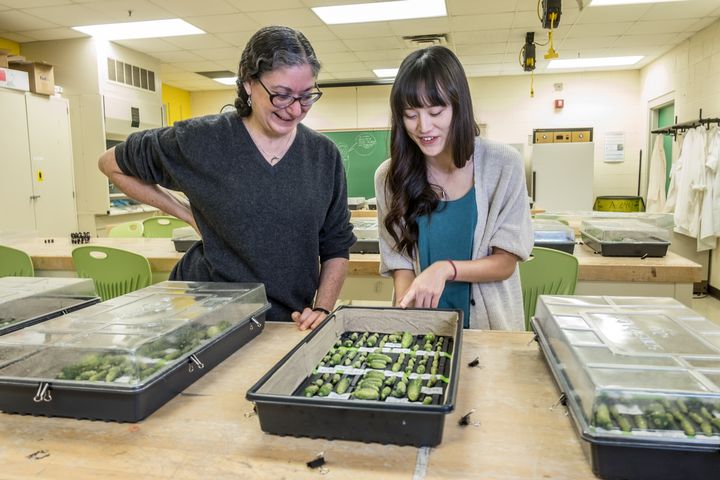Jul 7, 2020Managing cucurbit diseases with research, outreach
Michigan agriculture boasts more than 300 commodities, giving it a richness and diversity surpassed only by California in the U.S.
Specialty crops – fruits, vegetables, tree nuts, nursery crops and floricultural crops – are an essential aspect of this agricultural economy. Michigan’s pickling cucumber industry, for example, is the nation’s largest at an estimated value of nearly $50 million per year.
Rebecca Grumet has dedicated her career to assisting specialty crop growers. A professor in the Michigan State University Department of Horticulture, she is an expert in reproductive development and disease resistance in cucurbit crops such as cucumbers, melons, squash and watermelons.
Disease issues have cost U.S. watermelon producers more than $20 million over the last three years. Cucumbers have been affected by two particularly devastating diseases – downy mildew and Phytophthora fruit rot, caused by a pathogen called Phytophthora capsici. Because of these problems, cucumber growers lose an estimated $5 million annually.
Grumet is the lead investigator on a multi-institutional, nationwide research endeavor called the Cucurbit Coordinated Agricultural Project (CucCAP). The project began in 2015 with a $6.5 million grant from the Specialty Crop Research Initiative within the U.S. Department of Agriculture’s National Institute of Food and Agriculture.
CucCAP is rooted in a holistic approach to production, from breeding and pathology to economic analysis and outreach. A stakeholder advisory group, composed of commodity organizations and seed industry representatives from around the world, helps to set research priorities and provide support.
Researchers use genomics to better understand the genetic makeup of cucurbit species and breed disease-resistant varieties, one of the most effective tools to improve production when paired with a disease management strategy.
“We’ve consulted growers from across the country, and they have consistently mentioned diseases as their primary concern,” Grumet said. “Using the USDA germplasm collection as a valuable resource, we’ve been able to characterize important regions of the genome as it relates to disease resistance.”
Outreach is a fundamental part of CucCAP, and disease control information is available on the CucCAP website. The team also created a cucurbit genomics database website to serve as a central portal for genomics data and research.
Grumet has also investigated Phytophthora fruit rot, which targets cucumbers and numerous vegetable crops across the Midwest, through a project supported by the Pickle Packers International Agricultural Research Fund. She said spores can last up to five years in soil, so once a field is infected, management is arduous.
The Phytophthora capsici pathogen attacks developing fruit, leaving leaves and vines typically untouched. Young fruit’s contact with the soil and position under a dense canopy promote ideal conditions for the disease. Once fruit stops growing rapidly, however, it’s less likely to become infected. Grumet has sought to understand why.
“We’re looking at the genetic basis for what causes the transition to resistance,” she said. “Is there something we can activate sooner to make the fruit more resistant? We’ve also screened cucumber germplasm to find sources of resistance already occurring in young fruit, and there are some promising results.”
Grumet and her team have identified a trait to develop a new breeding line that shows reduced disease severity and progression. She indicated that seed from the line has been provided to several seed companies for further testing and breeding.
“Using modern genomic tools, we can efficiently introduce genes much quicker than traditional breeding,” Grumet said. “This is needed given the time-sensitive nature of dealing with destructive diseases.”
– Cameron Rudolph , Michigan State University

















